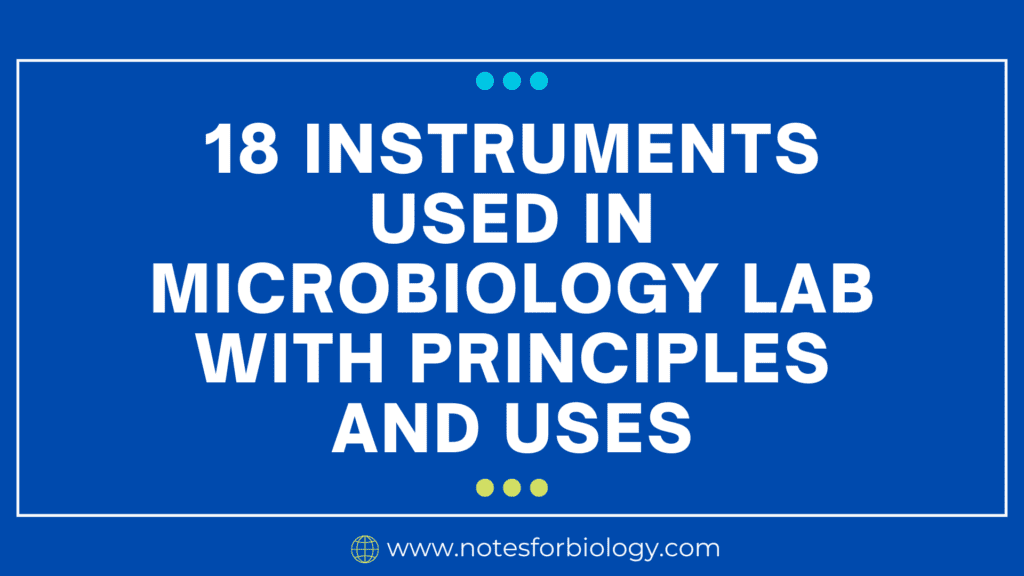Microbiology is the study of microorganisms, which are living organisms that are too small to be seen with the naked eye. These tiny life-forms include bacteria, archaea, viruses, fungi, protozoa, and algae. The key fields of microbiology include Medical Microbiology, Environmental Microbiology, Industrial Microbiology, Microbial Genetics, Immunology, Virology etc.
Table of Contents
The list of 18 essential Instruments Used in Microbiology , along with their working principles and common uses are:
Instruments Used in Microbiology
1. Analytical balance
An extremely sensitive Instruments Used in Microbiology laboratory tool called an analytical balance is used to quantify mass precisely, usually to the nearest 0.1 mg or more. To keep dust, air currents, and other outside elements from interfering with it, a clear draft shield encloses it
1.1 Working principle:
Electromagnetic Force Restoration (EMFR) Principle: This principle involves counteracting the weight of the object with an electromagnetic force.
Technology of Load Cells: An electrical signal is produced from an object’s weight using load cells.
1.2 Uses
Measuring small quantities of microbial samples for experiments and assays
Determining the dry weight of microbial biomass for growth studies and yield calculations.
2. Autoclave
One essential piece of Instruments Used in Microbiology labs for sterilizing media, tools, and other objects is an autoclave. To destroy all microbiological life, including bacteria, viruses, fungus, and spores, it uses high-pressure saturated steam.
2.1 Working principle
Steam is created by heating the water within the autoclave. Either an external steam source or an internal boiler can be used for this.
Sterilizes by combining steam, pressure, and time.
2.2 Uses:
- Sterilizing Culture Media
- Sterilizing Laboratory Instruments
3. Bunsen Burner
A Bunsen burner is a Instruments Used in Microbiology used for heating, sterilizing, and conducting combustion reactions in scientific research. It creates a precise, regulated flame by combining gas (often methane or propane) with air in a specific ratio.
3.1 Working principle:
Combustion, the chemical reaction that generates heat and light when a fuel (often a gas, like methane or propane) and an oxidant (air or oxygen) come together, is the fundamental idea behind the Bunsen burner.
3.2 Uses
It is frequently employed in procedures including heating, burning, and sterilizing. It is frequently used for micro-loop sterilization in medical or microbiology labs.
4. Centrifuge
An object can be rotated around a single axis with an outward force applied perpendicular to the axis using a centrifuge. With the use of a motor-driven centrifuge in the lab, components of a mixture can be separated by rotating a liquid sample. It is an essential Instruments Used in Microbiology
4.1 Working principle:
The theory of sedimentation underlies the operation of a centrifuge; smaller, less dense particles are driven towards the center while denser particles are driven away from it by the high rotational speed.
4.2 Uses:
The separation of particles suspended in a suspension is the main use of a centrifuge. It can be applied to the isotope separation process, blood components, nucleic acid separation, and cell organelle separation.
5. Colony counter
In microbiology labs, a colony counter is a Instruments Used in Microbiology to count and document the quantity of visible colonies on an agar plate or other culture media. It expedites and streamlines the colony counting procedure, which is necessary for a number of microbiological applications, including figuring out the populations of bacteria or fungi in a sample.
5.1 Working principle:
Different sized plates that are scanned on top using UV, white light, or fluorescent illumination can be accommodated by this apparatus.
5.2 Uses:
To determine the concentration of microorganisms in liquid culture, a colony counter is mostly used to count the number of colonies on a culture plate.
6. Deep freezer
Ultra-low temperature (ULT) freezers, sometimes referred to as deep freezers, are specialized Instruments Used in Microbiology to keep chemicals, biological samples, and other delicate materials at very low temperatures. These freezers are vital for keeping samples intact and long-lasting since they stop biological activity and deterioration.
6.1 Working principle:
Deep freezers operate on the premise that various materials can be protected and preserved since microbial development is minimal at extremely low temperatures.
6.2 Uses:
Many items used in laboratories can be preserved for an extended length of time using a deep freeze. In laboratories, deep freezers are used to hold and preserve supplies for longer periods of time, including food, medications, blood samples, injections, and medical equipment.
7. Homogenizer
An industrial or Instruments Used in Microbiology called a homogenizer is used to combine and dissolve materials to produce a homogeneous mixture. It functions by utilizing mechanical forces, frequently at the microscopic level, to mix and spread components through turbulence, cavitation, and shear. Homogenizers are necessary for the production of stable emulsions, suspensions, and cell lysates in a variety of industries, including biology, food processing, pharmaceuticals, and cosmetics.
7.2 Working principle:
The homogenization process is carried out through a metal rod in the shape of a comb at the end of the homogenizer, which serves as the orifice.
7.2 Uses:
The main purpose of a homogenizer is to split up cells so that cell organelles can be obtained for various microbiological procedures.
8. Hot plate
A hot plate is an Instruments Used in Microbiology used in electric heating device with a flat, usually metal surface used in laboratories for heating samples, solutions, and other materials uniformly and precisely.
8.1 Working principle:
Unlike the traditional ways of producing heat through fire, a hot plate produces heat by the flow of electricity.
8.2 Uses:
They are used over water baths as water baths might be hazardous in case of any spills or overheating.
9. Hot air oven
A hot air oven is a type of Instruments Used in Microbiology that is used to sterilize materials and equipment. It is frequently used in scientific research, healthcare, and other areas where contamination control is crucial. It uses dry heat to produce sterilization.
9.1 Working principle:
One kind of dry heat sterilization used on dry materials and materials that don’t melt or catch fire at high temperatures is the hot air oven
9.2 Uses:
A hot air oven can be used to sterilize materials like glassware, metal equipment, powders, etc.
10. Incubator
A tool used in labs for maintaining and growing microorganisms and cultures is called an incubator. An incubator offers the ideal conditions for microorganism growth, including the right amount of moisture, pressure, and temperature.
10.1 Working principle:
The incubator is based on the principle of maintaining a proper atmosphere for the growth of microorganisms.
10.2 Uses:
Numerous fields of study use incubators, such as cell culture, pharmacological, hematological, and biochemical research.
11. Laminar Air Flow/ Laminar Hood
Laminar Hood is a Instruments Used in Microbiology primarily for processes or instruments sensitive to microbial contamination.
11.1 Working principle:
This Instruments Used in Microbiologysterilizes the workstation by passing sterile air via a shortwave UV germicidal light and a High-Efficiency Particulate Air (HEPA) filter to generate a sterile atmosphere.
11.2 Uses:
It is used for experiments related to plant tissue culture and for the experiments of genetic transformation.
12. Magnetic stirrer
A magnetic stirrer is a tool that rotates a stir bar inside a container using a magnetic field to stir the liquid inside. Usually, it consists of a set of stationary electromagnets or a revolving magnet that are positioned beneath the surface that the container is placed on.
12.1 Working principle:
This apparatus is made up of a revolving magnetic or electromagnet that generates a magnetic field that rotates, enabling the heavy metal stir bar to move within the jar.
12.2 Uses:
This device is used in place of other stirrers as it is noise-free and because the size of the stir bar is so tiny, there is less chance of contamination.
13. Magnetic stirrer
A microscope is a device that produces magnified images of small objects, enabling detailed observation and analysis at a scale not possible with the naked eye.
13.1 Working principle:
Magnification is a fundamental concept in a microscope. One can achieve varying positions, types, and magnifications of the image depending on how the object is positioned in relation to the lens or electromagnets.
13.2 Uses:
They are primarily used for the observation of minute particles which cannot be observed with naked eyes.
14. PH Meter
A pH meter is an electronic device used to measure the acidity or alkalinity (pH) of a solution. It provides a numerical value representing the hydrogen ion concentration, which indicates whether a solution is acidic, neutral, or alkaline.
14.1 Working principle:
A solution’s hydrogen ions exchange with the electrode’s positive charges when the electrode-equipped bulb is submerged in it, creating an electrochemical potential that is shown on the display in pH units.
14.2 Uses:
It can be used to measure the acidity level in wine and cheese during their production.
15. Spectrophotometer
The spectrophotometer is an optical Instruments Used in Microbiology for measuring the intensity of light in relationto wavelength.
15.1 Working principle:
The Beer-Lambert Law, which asserts that the absorbance of light by a solution (of a specific wavelength) is directly proportional to the concentration of the material, is the foundation of spectrophotometry
15.2 Uses:
In a microbiology laboratory, a spectrophotometer is applied for the measurement of the substance concentration of protein, nucleic acids, bacterial growth, and enzymatic reactions.
16. Vortex mixer/Vortexer
A vortex mixer is one of the basic technologies used for the mixing of samples in glass tubes or flasks in laboratories.
16.1 Working principle:
It is predicated on the straightforward idea of stirring the mixture to initiate reactions and homogenize it.
16.2 Uses:
Vortex mixer is mostly used for the mixing of various sample fluids in the sample tubes and also allows for the homogenization of cells and cell organelles.
17. Water Bath
In a microbiology lab, a water bath is a laboratory equipment used to heat or maintain the temperature of liquid samples or materials in small containers.
17.1 Working principle:
The gadget uses a sensor to measure the temperature of the water, which it then amplifies. A control system uses this information to create a signal that instructs the heating system to heat the water to the appropriate temperature.
17.2 Uses:
Water baths are primarily used for heating samples under a controlled temperature.
18. Water Distiller
A device that uses the distillation process to purify water is called a water distiller. The medical industry, organic chemistry labs, microbiology labs, and medical laboratories all frequently employ this device.
18.1 Working principle:
Distillation is the foundation of a water distiller.
This method yields pure distilled water by heating water to a boil and then condensing it into a liquid.
18.2 Uses:
It is used to obtain distilled water required for many lab tests as well as for the preparation of culture media.
FAQ (Frequently Asked Questions)
What is the basic instruments used in laboratory?
The basic instruments used in laboratory are Bunsen burner ,microscope ,water baths ,fume hoods etc
How do you properly use and maintain microscope?
keep lenses clear of slides, always clean carefully and with the appropriate cleaning solution and always use the dust cover when the microscope is not in use.
What is the use of pH meter?
A pH meter is a device that measures a solution’s acidity or alkalinity, commonly referred to as pH. The measurement used to express the degree of acidity or alkalinity is called pH. It is quantified using a range of 0 to 14.
Related Article



